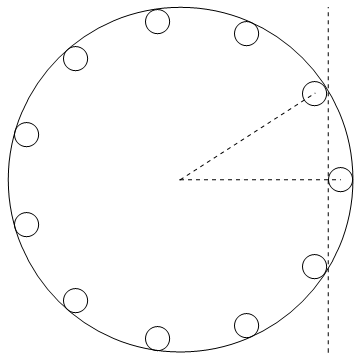For a circle, suppose we distribute $n$ dots evenly near the circumference.

One dot has a center at $(1-r,0)$ and the adjacent dots have centers at $$((1-r)\cos(2\pi/n),\ \pm (1-r)\sin(2\pi/n))$$ The middle one goes as far to the left as $1-2r$, and the neighbors go as far to the right as $(1-r)\cos(2\pi/n)+r$ To avoid collinearity, we need \begin{align} (1-r)\cos(2\pi/n)+r &< 1-2r\\ n &< 2\pi/\arccos\left(\frac{1-3r}{1-r}\right) \end{align} Asymptotically, this means we can choose $n$ as large as $$\frac{\pi}{\sqrt{r}}\left(1-\frac{2r}{3}+O(r^2)\right)$$ which is a reasonable lower bound for the problem.
For a unit square, $[-1/2,1/2]^2$, putting all the same set up alsodots on one circle still seems to work well. Instead of using one circle, we
We can try connectingan alternative, putting dots on four circular arcs (black, blue, purple, red) each of which staystays closer to one of the four sides.
The rightmostblack arc will have a center at $(-h,0)$, a radius of $k=1/2+h-r$, and a dot with a center at $(1/2-r,0)$.
The dashed lines show radii of the black arc; we call the smallest central angle $\alpha$ and the biggest central angle $\beta$. Then the total number of dots on that arc will be twice the floor of $\alpha/\beta$$\beta/\alpha$ where \begin{align} -h+k\cos(\alpha)&=k\sin(\alpha)\\ -h+k\cos(\beta)&=1/2-3r \end{align}\begin{align} -h+k\cos(\beta)&=k\sin(\beta)\\ -h+k\cos(\alpha)&=1/2-3r \end{align} Empirically, we maximize $\alpha/\beta$$\beta/\alpha$ at $h=0$, which is to say that we might as well take the four circular arcs to be part of the same circle. In the diagram, that corresponds to spacing the dots evenly outside the light gray circle instead.

